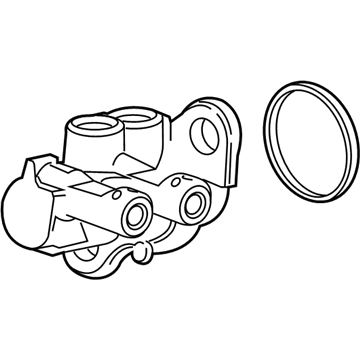
My Garage
My Account
Cart
Genuine Chevrolet Traverse Brake Master Cylinder
- Select Vehicle by Model
- Select Vehicle by VIN
Select Vehicle by Model
orMake
Model
Year
Select Vehicle by VIN
For the most accurate results, select vehicle by your VIN (Vehicle Identification Number).
2 Brake Master Cylinders found
Chevrolet Traverse Cylinder Kit, Brk Mas
Part Number: 84644599$100.41 MSRP: $197.47You Save: $97.06 (50%)Ships in 1-2 Business DaysChevrolet Traverse Cylinder Assembly, Brk Mas
Part Number: 84744483$91.20 MSRP: $285.22You Save: $194.02 (69%)Ships in 1-3 Business Days
Chevrolet Traverse Brake Master Cylinder
Brake Master Cylinder is a critical assembly in Chevrolet traverse cars used to translate the foot force into hydraulic pressure that operates the slave cylinders. This system employs hydraulic fluid to translate force from the master cylinder's piston to the slave cylinders improving force and displacement. The master cylinder is used in commanding the operations of calipers or drum brakes for the braking process and where the slave Cylinder is employed, for disengagement of the clutch. Chevrolet Traverse vehicles generally employ a diagonally split hydraulic booster, one piston of the master cylinder manages one circuit to guarantee that the vehicle retains braking power even when one of the circuits has failed. In summary, the Brake Master Cylinder is quite instrumental in controlling hydraulic force and the pressures involved in the safe operation of the vehicle.
Each OEM Chevrolet Traverse Brake Master Cylinder we offer is competitively priced and comes with the assurance of the manufacturer's warranty for the part. Furthermore, we guarantee the speedy delivery of your orders right to your doorstep. Our hassle-free return policy is also in place for your peace of mind.
Chevrolet Traverse Brake Master Cylinder Parts Questions & Experts Answers
- Q: How to remove the brake master cylinder on Chevrolet Traverse?A:To remove the brake master cylinder, start by turning off the ignition switch and removing the air filter element. If necessary, remove the air filter cover and outlet duct as well. Use a syringe or turkey baster to remove as much fluid as possible from the reservoir. Disconnect the Brake Booster check valve and the electrical connector at the brake fluid level switch. Remove the windshield washer fluid heater if it is equipped. Place rags under the fluid fittings and prepare caps or plastic bags to cover the ends of the lines. Clean off any dirt or debris from around the brake line fittings. Loosen the fittings at the ends of the brake lines and plug the ends to prevent contamination. Remove the nuts attaching the brake master cylinder to the power booster and carefully pull the brake master cylinder off the studs. If installing a new brake master cylinder, spread the tabs on the bottom of the reservoir, lubricate new reservoir seals with brake fluid, and secure the reservoir to the new brake master cylinder. To install the new brake master cylinder, bench bleed it first by mounting it in a vise and attaching bleeder tubes to the outlet ports. Fill the reservoir with brake fluid and slowly push the pistons into the brake master cylinder to expel air. Repeat until no more air bubbles are present. Remove the bleed tubes and install plugs in the open ports. Install the brake master cylinder over the studs on the power brake booster and tighten the attaching nuts. Thread the brake line fittings into the brake master cylinder and tighten them securely. Fill the reservoir with fluid and bleed the brake master cylinder and brake system. Test the brake system before placing the vehicle into normal service.
Related Chevrolet Traverse Parts
Browse by Year
2024 Brake Master Cylinder 2023 Brake Master Cylinder 2022 Brake Master Cylinder 2021 Brake Master Cylinder 2020 Brake Master Cylinder 2019 Brake Master Cylinder 2018 Brake Master Cylinder 2017 Brake Master Cylinder 2016 Brake Master Cylinder 2015 Brake Master Cylinder 2014 Brake Master Cylinder 2013 Brake Master Cylinder 2012 Brake Master Cylinder 2011 Brake Master Cylinder 2010 Brake Master Cylinder 2009 Brake Master Cylinder





